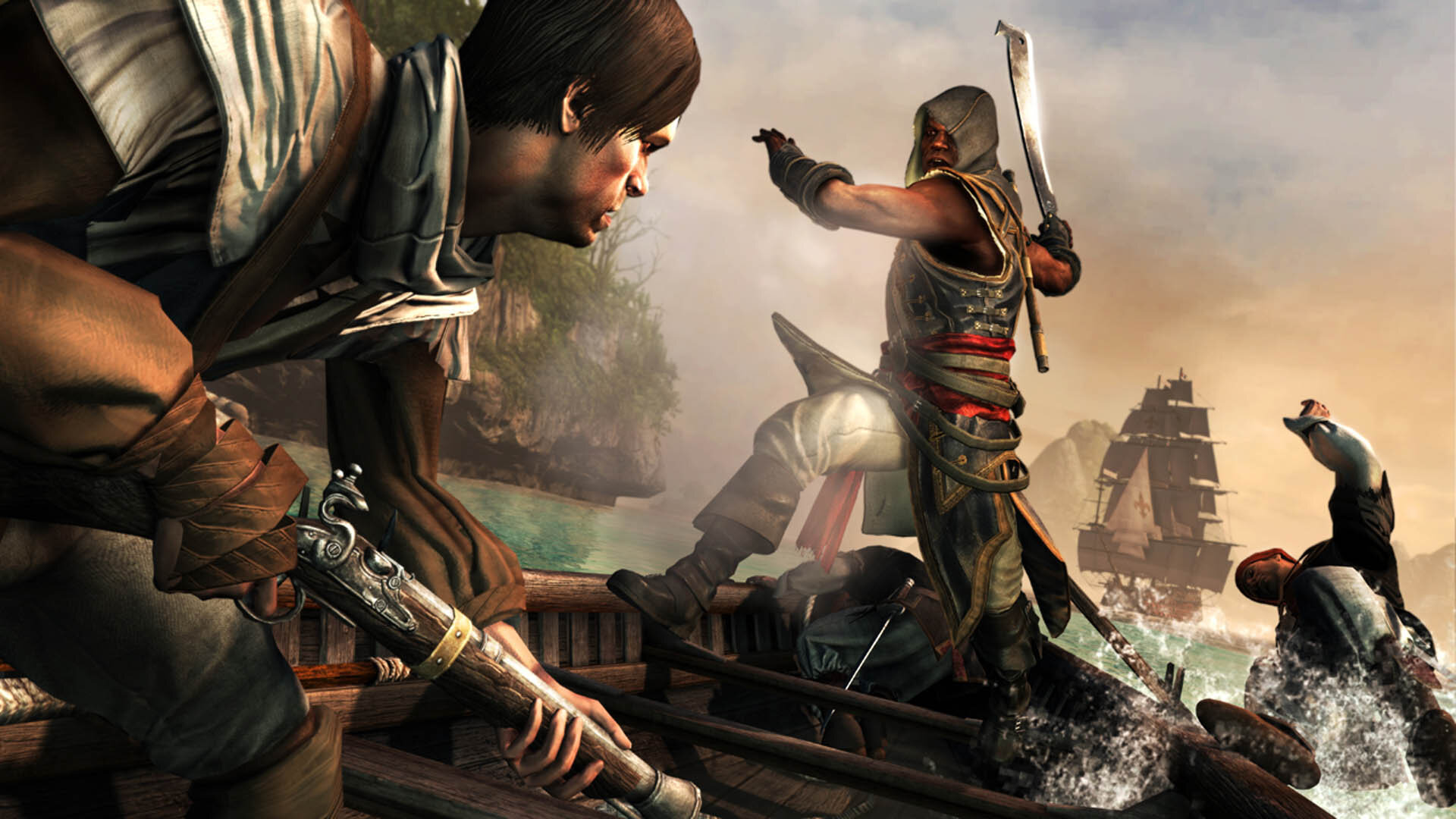Kill the Overseer! The Gamification of Slave Resistance
Isabelle Williams, Guest Contributor
What does it mean to make slave resistance playable? In Kill the Overseer!: The Gamification of Slavery Resistance (2020), Sarah Juliet Lauro builds a playable archive of digital representations of slave resistance in order to meditate on this very question. Lauro urges readers to join her in staring at what she calls the “void,” as she works through the absence of celebratory monuments to slave resistance and revolts. This silence depends on a specific understanding of the slave and of what the figure of the slave allowed for.
Assassin’s Creed: Freedom Cry (2013).
While it might be a short text, Lauro tackles a near impossible question which is highlighted and helped by her objects of study: videogames. The book constantly wrestles with the status of the video game as an object of academic inquiry and the video game as a mode of playable resistance. In order to do this, Lauro examines videogames explicitly about slave revolt. Thinking back to the “void,” or as Lauro sometimes terms it, the “gap, Lauro uses video games to highlight the limitations of traditional literary records of slave revolts in texts, while simultaneously locating the potential problems of making slave revolts playable. Lauro insists that the grammar of violence, the structural limitations of grammar that is present in narrative texts, is a grammar that is continuously slipped into because of the limitations of written language. She simultaneously assumes the grammar of video games draw on a “semiotics of obstruction, absence, blockage, and aporia to leave open a space for what cannot be said; they speak of the horrors of the transatlantic slave trade and anticipate a future, as yet unarrived and perhaps unimaginable, when we will have fully reckoned with the past” (Lauro 9). In other words, Lauro is looking to video games and asking if they can do what written narratives cannot. The past is never past.
The urgency of the book comes to light in this observation that the past is perpetually present. In other words, the “void” for Lauro is an actively maintained gap filled with silences, silences which can only be highlighted through the questions Lauro poses through the text: Can you play as the slave? Can this playing be called resistance? While Lauro’s conception of silences is borrowed from Haitian scholar Michel-Rolph Trouillot, “silence”, “void”, and “gap” are three terms that are used interchangeably throughout the text, though there seems to be nuance between the terms. What’s clear from the text is that this absence is present, active, and must be tended without providing a solution. The reason Lauro does not offer a solution is because Lauro sees offering a solution as a type of returning to the grammar of violence. because, for Lauro, offering a solution is a type of returning to, or slipping into, the grammar of violence.
Assassin’s Creed: Freedom Cry (2013).
The importance of this book can be summarized by this sentence: “In brief, because mainstream U.S. culture is unwilling to celebrate slave resistance in the form of statuary and monuments, I wanted to explore media where this work was being done” (Lauro 4). Lauro unpacks the US’s unwillingness to remember slavery while locating how celebrating slave resistance through play involves tension. It’s important to note that Lauro looks at a broad body of game categories including educational games, mainstream videogames, and incomplete games. The archive Lauro constructs, games of slave resistance, for the most part are those with an educational agenda. For example, Lauro focuses on the video game Freedom! (1992) created by Minnesota Education Computing Consortium (creators of the popular educational game Oregon Trail). In this game, the player plays as a slave whose ability to complete the mission depends on randomly-generated skills determined by the computer (from literacy skills and swimming skills to work ethic). The game’s accompanied by educational resources explaining the history of the revolt to the player, or in this case, the student. However, Lauro astutely notes that these resources prioritize the escape of a figure like Harriet Tubman, while dismissing violent revolt by the likes of Nat Turner. The problem of violence and videogames isn’t a new one, but as Lauro notes, Scholastic’s attempt to celebrate “peaceful” slave resistance and condemn “violent” revolt draws a problematic line between right and wrong ways to resist.
The tension of playing slave resistance also deals with the difficulty of defining how resistance gets read by others. Such tension’s not isolated to this game. Lauro examines another educational game created by National Geographic, Underground Railroad: Journey to Freedom, a first-person iPad game. Lauro points out to the reader two glaring problems: First, the game never names the playable character. Secondly, it emphasizes the “thrill of escape,” providing two paths to freedom while also allowing for the possibility of being caught (Lauro 17). As demonstrated by the emphasis on the “thrill of escape” and disavowing the actual act of resistance, there seems to be a hesitance within these educational games to celebrate slave resistance. Therefore, the tension here is one of what this is missing, what is not able to be played.
Assassin’s Creed: Liberation (2012).
The tension of the educational aspects of these games brings up another question not flagged by Lauro. Who is the player? If we assume, as Lauro does, that students are playing most of these games with a lesson in mind, is the race of the player important? Is this yet another form of digital blackface that’s become more prolific since blackface minstrelsy? While Lauro doesn’t address this question, it’s another silence pointing us back to the void of slavery’s afterlife. The notion of the universal player, or the idea that each player is same, continues to be a problem that Lauro’s argument constantly pressures.
One of Lauro’s later chapters, “Untranslated,” looks at what is untranslatable which indirectly addresses this issue of universal player. In this chapter, Lauro addresses the Assassin’s Creed franchise, specifically moments within the games of untranslated language. Lauro specifies that the “foreign language shared in the gameplay are never translated for the player” (Lauro 55). This linguistic gulf, another void that Lauro is pointing the readers to, has a specific function. For Lauro, the untranslated language is a “gulf provides a productive obstacle to the player’s complete absorption into the playable character’s identity” (Lauro 55). It is here that the stakes of this book are made even more clear: there are some experiences that are untranslatable. This untranslatability is the problem of making slave resistance playable for Lauro. As Lauro states “As we’ve seen, game texts can also work in a productive manner that emphasizes that such a narrative may speak differently to gamers of diverse ancestry by resistance the player’s access to the full story through the use of language or requiring a labor of cultural recognition on the part of the player to unlock parts of the story” (Lauro 63). But what if parts of the story are unlockable?
Lauro’s conclusion is one that refuses to offer solutions. Instead, Lauro states “narratives about slave resistance should be reevaluated, as the work of understanding our culture’s relationship to the history of slavery and resistance and its enduring legacy is all the more urgent in the contemporary political climate. The digital texts that I’ve presented here use their very form to underscore this quandary: inhabiting the subject position of the historical rebel slave is ultimately bracketed as an impossibility by the games’ formal devices” (Lauro 89). By impossibility of occupying the subject position, Lauro is again hinting at the problem created when it is assumed there is a universal player. This impossibility is an impossibility rooted in the limitations of thinking and ultimately a failure of language.
This conclusion of the impossibility of inhabiting the subject position of the rebel slave is a conclusion deeply immersed in Michel-Rolph Trouillot’s notion of “thinking the unthinkable.” This sentiment is echoed in Lauro’s statement that “we can’t win slave resistance; we can’t even really know it” (Lauro 89). To know the unknowable falls into the same conundrum of thinking the unthinkable, speaking the unspeakable, and perhaps even playing the unplayable. In many ways, Lauro’s text attempts to think the unthinkable and celebrate the historically uncelebrated with the tools of the master. Lauro refuses to neatly tie up the ends of her inquiries and instead leaves the reader with a collection of questions. These questions that Lauro leaves the reader with are absolutely essential as they open up a dialogue that’s urgently needed. Although the text is short, Lauro’s questions are urgent, compelling, perhaps even unthinkable. Lauro invites us to sit and think what it means to play critically.





